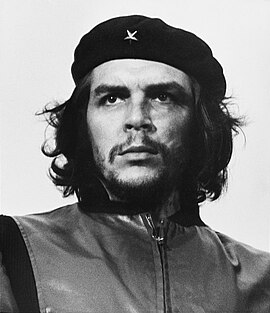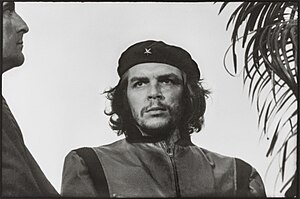
Back غيريليرو هيروويكو Arabic Guerrillero Heroico Azerbaijani গেরিইয়েরো এরোইকো Bengali/Bangla Guerrillero Heroico Catalan Guerrillero Heroico Czech Guerrillero Heroico Welsh Guerrillero Heroico German Τσε Γκεβάρα (φωτογραφία) Greek Che Guevara (foto) Esperanto Che Guevara (fotografía) Spanish
| Guerrillero Heroico | |
|---|---|
 Alberto Korda's photograph of Che Guevara | |
| Artist | Alberto Korda |
| Completion date | March 5, 1960 |
| Type | Photograph |

Guerrillero Heroico (English: "Heroic Guerrilla Fighter") is an iconic photograph of Marxist revolutionary Che Guevara taken by Alberto Korda. It was captured on March 5, 1960, in Havana, Cuba, at a memorial service for victims of the La Coubre explosion. By the end of the 1960s, the image, in conjunction with Guevara's subsequent actions and eventual execution, helped solidify the leader as a cultural icon.[2] Korda has said that at the moment he shot the picture, he was drawn to Guevara's facial expression, which showed "absolute implacability"[3] as well as anger and pain.[4] Years later, Korda would say that the photograph showed Che's firm and stoical character.[5] Guevara was 31 years old at the time the photograph was taken.
Emphasizing the image's ubiquitous nature and wide appeal, the Maryland Institute College of Art called the picture a symbol of the 20th century and the world's most famous photograph.[6] Versions of it have been painted, printed, digitized, embroidered, tattooed, silk-screened, sculpted or sketched on nearly every surface imaginable, leading the Victoria and Albert Museum to say that the photograph has been reproduced more than any other image in photography.[7] Jonathan Green, director of the UCR/California Museum of Photography, has speculated that
Korda's image has worked its way into languages around the world. It has become an alpha-numeric symbol, a hieroglyph, an instant symbol. It mysteriously reappears whenever there's a conflict. There isn’t anything else in history that serves in this way.[8]
The history and contemporary global impact of the image is the basis for the 2008 documentary Chevolution, directed by Trisha Ziff,[9] along with the 2009 book Che's Afterlife: The Legacy of an Image by Michael Casey.[10]
- ^ Brand Che: Revolutionary as Marketer's Dream by Michiko Kakutani, The New York Times, April 20, 2009
- ^ Communists, Capitalists still buy into Iconic Che Photo, Author says by Brian Byrnes, CNN, May 5, 2009
- ^ Che Guevara: A Revolutionary Life, by Jon Lee Anderson, 1997, pg 465
- ^ Che Guevara: Revolutionary & Icon, by Trisha Ziff, Abrams Image, 2006, pg 15
- ^ "Che Guevara: Revolutionary & Icon", by Trisha Ziff, Abrams Image, 2006, pg 33
- ^ Maryland Institute of Art, referenced at BBC News, "Che Guevara photographer dies", May 26, 2001. Online at BBC News, accessed January 4, 2006.
- ^ "V&A: The story of an image, exhibition organised by UCR/California Museum of Photography". Vam.ac.uk. Retrieved 2011-03-05.
- ^ "Che as revolutionary and icon, by Corinna Lotz". Aworldtowin.net. Retrieved 2011-03-05.
- ^ DVD Review: Chevolution Archived 2010-02-14 at the Wayback Machine by David Van Der Haeghen, DVD Town, January 16, 2010
- ^ Brand Che: Revolutionary as Marketer’s Dream by Michiko Kakutani, The New York Times, April 20, 2009
© MMXXIII Rich X Search. We shall prevail. All rights reserved. Rich X Search